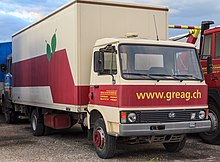OM X series
The OM X series was a light truck model developed by the Italian manufacturer OM and later sold internationally under various brand names.
The light trucks came onto the market as the OM 40-190 in 1967 as the successor to the OM Leoncino . It was a front handlebar with a tilting driver's cab; The "snorkel" behind the cab roof, over which the engine's air intake ran, was characteristic. As a revised model, it was offered in Italy as the OM and Fiat S series from 1973 to 1976.
As part of the incorporation of OM into the new Iveco group in 1975, the model was also sold under the various brands incorporated into Iveco from 1976, in Italy as OM and Fiat Series "Z", in France as Unic and in Germany as Magirus-Deutz X series.
The Magirus-Deutz variant was powered by air-cooled Deutz engines , the other variants by water-cooled Fiat engines. Chassis for any superstructure, flatbed trucks , closed box vans and fire engines were available .
When the Iveco Group decided to phase out the old brand names of the manufacturers that had been absorbed by Iveco, the X trucks were changed to the uniform brand name Iveco and the type designation "Zeta" (also preceded by "Turbo" - in the early 1980s) Lettering). Within the Iveco range, the Zeta series ranks between the Daily I transporter, which is derived from a Fiat model, and the MK series from the Magirus-Deutz range .
The (Turbo) Zeta were also available as a licensed product under the Zastava brand .
In Germany, the X series was offered until 1992, with the panel van being replaced by the Daily in the mid-1980s. The truck models were replaced by the Iveco Eurocargo , which also replaced the MK series. Today the X-series trucks have largely disappeared from the German streetscape. Since the truck had a "cheap image", the workmanship, especially in the interior, was not very high quality and the body rusted quickly, the specimens that have remained to this day are not in demand with commercial vehicle collectors either, although the early ones built into the 1970s Vehicles now have the legal status of classic cars due to their age .
Timeline
| Timeline of Iveco trucks offered in Germany since 1975 | |||||||||||||||||||||||||||||||||||||||||||||||||||||||
|---|---|---|---|---|---|---|---|---|---|---|---|---|---|---|---|---|---|---|---|---|---|---|---|---|---|---|---|---|---|---|---|---|---|---|---|---|---|---|---|---|---|---|---|---|---|---|---|---|---|---|---|---|---|---|---|
| Weight class | 1970s | 1980s | 1990s | 2000s | 2010s | 2020s | |||||||||||||||||||||||||||||||||||||||||||||||||
| 5 | 6th | 7th | 8th | 9 | 0 | 1 | 2 | 3 | 4th | 5 | 6th | 7th | 8th | 9 | 0 | 1 | 2 | 3 | 4th | 5 | 6th | 7th | 8th | 9 | 0 | 1 | 2 | 3 | 4th | 5 | 6th | 7th | 8th | 9 | 0 | 1 | 2 | 3 | 4th | 5 | 6th | 7th | 8th | 9 | 0 | 1 | 2 | 3 | 4th | 5 | 6th | 7th | 8th | 9 | |
| Off-road vehicle | Massif | ||||||||||||||||||||||||||||||||||||||||||||||||||||||
|
Vans and small trucks |
Daily I. | Daily II | Daily III | Daily IV | Daily V | Daily VI | Daily VII | ||||||||||||||||||||||||||||||||||||||||||||||||
| X series, (turbo) zeta | |||||||||||||||||||||||||||||||||||||||||||||||||||||||
| Light to medium-weight trucks |
EuroCargo I | Eurocargo II | Eurocargo III | ||||||||||||||||||||||||||||||||||||||||||||||||||||
| MK series (club of four vehicles) | |||||||||||||||||||||||||||||||||||||||||||||||||||||||
| Medium to heavy trucks |
D series | ||||||||||||||||||||||||||||||||||||||||||||||||||||||
| M and T series , TurboTech , TurboStar | EuroStar , EuroTech | Stralis I | Stralis II | Stralis hi-way | S-Way | ||||||||||||||||||||||||||||||||||||||||||||||||||
| Construction vehicles | P series | EuroTrakker | Trakker I. | Trakker II | |||||||||||||||||||||||||||||||||||||||||||||||||||
| “Baubullen” hooded wagon, PA series | |||||||||||||||||||||||||||||||||||||||||||||||||||||||
| In 1975 the commercial vehicle manufacturers Fiat , Lancia , OM , Unic and Magirus-Deutz went into Iveco . The table shows the following colors: | ||||
| models taken over from Magirus-Deutz | models adopted from OM | models derived from Fiat models | models derived from Santana models | models developed by Iveco itself |





